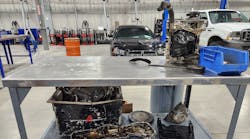To gain some insight into the particulars of refrigeration systems for medium duty trucks, Fleet Maintenance visited with Tina Hickman, product manager, truck products, for Carrier Transicold (www.carrier.com/truck-trailer), Truck, Trailer, Rail Division. The company helps improve transport and shipping temperature control with a complete line of equipment and services for refrigerated transport and cold chain visibility.
Fleet Maintenance (FM): What are the most important considerations when specifying refrigeration systems?
Hickman: The most important factors include insulation type and thickness, net box (body) size, number of door openings and the anticipated maximum outside temperature where the truck will travel. In addition, the design temperature or temperature range for the box should be determined – in other words, identify the anticipated temperature set points that will be required for the type of cargo.
Once these parameters have been determined, an estimated refrigeration load requirement can be calculated for the truck body. This requirement can then be compared with refrigeration systems’ rated capacities to determine the best fit for the application.
For example, a large truck body maintaining frozen products in a hot ambient environment will require a larger refrigeration unit than a small box maintaining perishable products in a mild ambient environment.
When considering system capacities, it is also important to consider the average amount of airflow the evaporator fans provide for the product.
FM: What types of truck refrigeration technologies are available, and how can a fleet determine which is best for its needs?
Hickman: The two most common types of truck refrigeration systems are diesel and direct drive. Cold plate/eutectic systems can also be utilized and may be popular in some applications. However, they are not as widely used as diesel and direct drive technology, primarily because of the lack of application flexibility, since diesel and direct drive units provide both heating and cooling across a wide range of thermostat settings.
Direct drive units are primarily used on vans or smaller truck applications where short, local deliveries are necessary – for example, box sizes up to 12’ in length for frozen products or 16’ to 18’ for perishable products.
Direct drive units have a compressor mounted to the vehicle’s engine, similar to how an automotive air conditioning system is designed. While this eliminates the diesel engine in a standard truck refrigeration unit, it does require the vehicle engine to be running to provide refrigeration.
Most truck refrigeration applications are more rigorous and require autonomy from the vehicle engine, necessitating a refrigeration unit with its own diesel engine. For these reasons, the diesel-powered unit is North America’s industry standard for box truck applications.
Diesel refrigeration technology produces constant cooling capacity versus direct drive technology, where capacity typically varies with the speed of the vehicle engine or cold plates, which may lose effectiveness over the course of the route.
As with direct drive units, diesel units are available in different sizes to suit the application. Multi-temperature versions can refrigerate two compartments at different temperatures with the installation of a second evaporator in the remote compartment. This enables both frozen and perishable goods to be delivered using a single truck.
FM: Is electric standby important?
Hickman: Yes, because it allows shippers to secure their loads, plus it reduces costs and the environmental impact of their operations. With electric standby technology, drivers can connect the refrigeration unit to an electric circuit during periods where the truck is stationary, such as during loading, staging or storing products on the vehicle overnight.
Electric standby allows the engine in the refrigeration unit – or the vehicle engine in the case of a direct drive system – to be shut off. This can result in significant operational savings because the cost of operating on electricity is typically less than the cost of burning fuel. In addition, utilizing electric standby reduces engine hours and allows owners to save on maintenance costs, such as oil and filter changes, as well as other engine-related costs.
Equally important is the fact that running on electric standby also reduces noise and local diesel exhaust emissions for those fleet and distribution operations located in sensitive neighborhoods.
FM: How important is “after sales” support?
Hickman: Regularly scheduled preventive maintenance is important in order to prolong the life of the equipment. Obtaining support from a dealer who understands the refrigeration unit and OEM maintenance requirements is vital, especially as equipment becomes more technically sophisticated in providing value-added benefits to refrigerated fleets.
Performing service at the proper intervals will help maximize fuel economy and reduce downtime, which can also reduce the total cost of ownership.
Extended warranty options and comprehensive maintenance and repair agreements provide a cost-effective means for owners to adhere to OEM service intervals.



